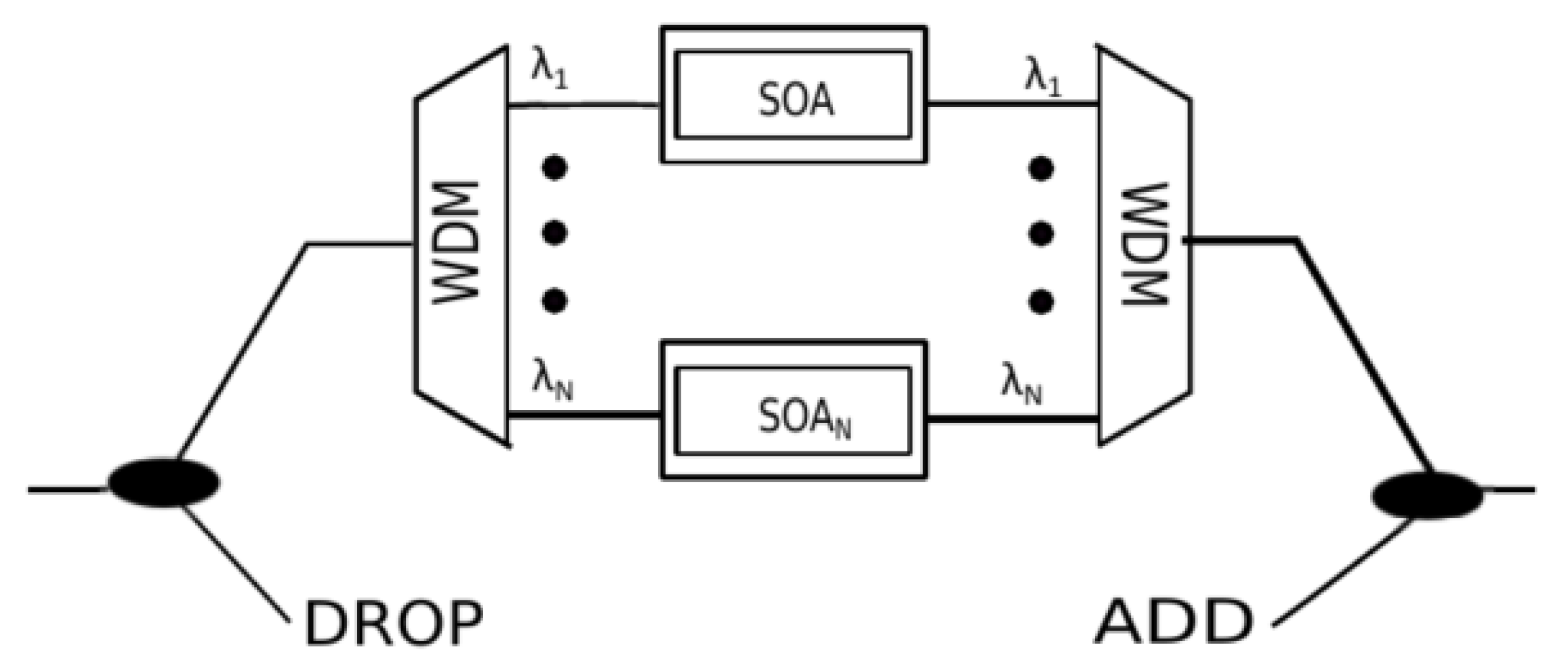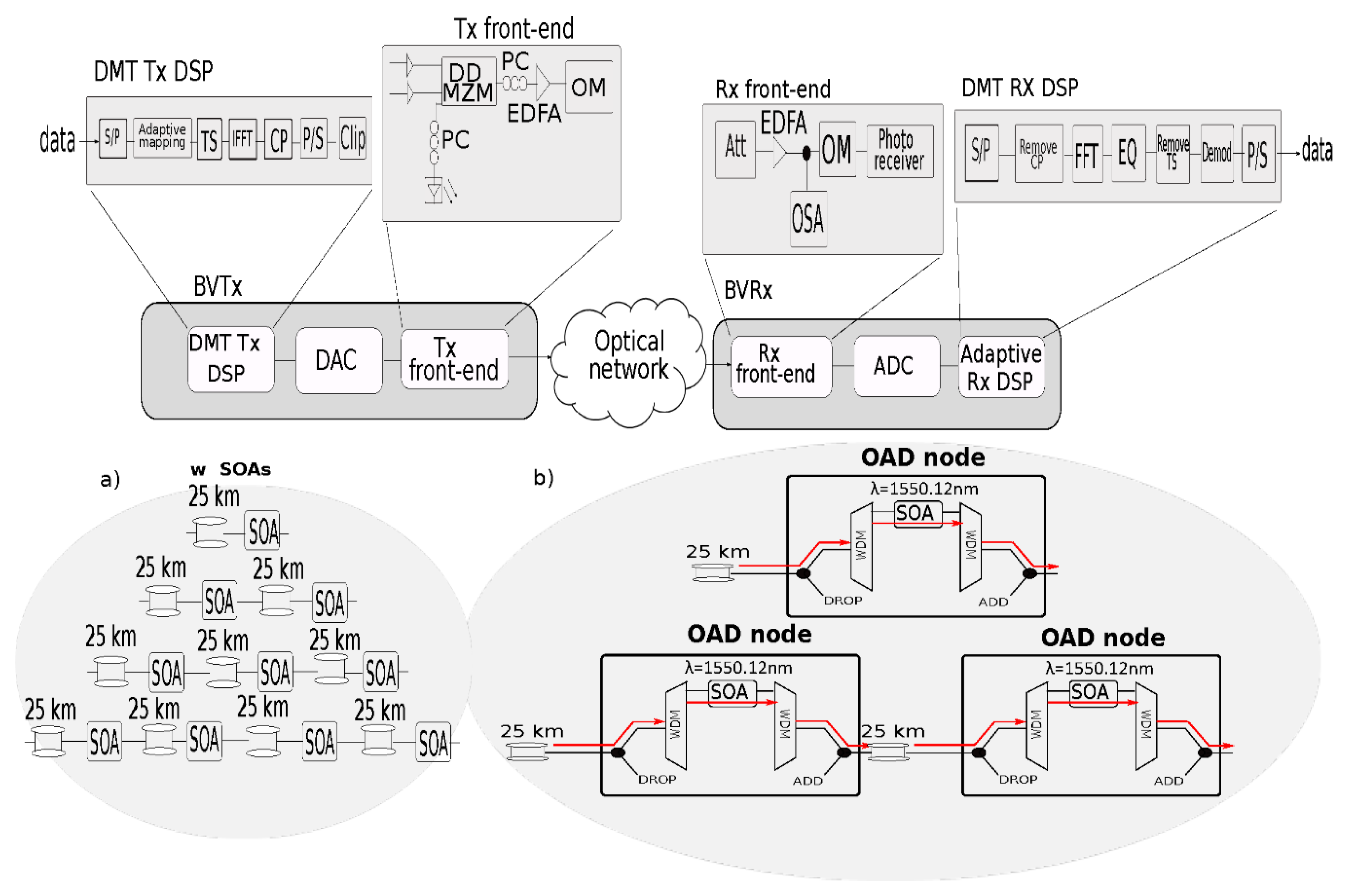Programmable Adaptive BVT for Future Optical Metro Networks Adopting SOA-Based Switching Nodes
Abstract
:1. Introduction
2. S-BVT Architectures Tailored for Optical Metro Networks
3. SOA Technology for Optical Metro Network Nodes
4. BVT with Switching Nodes Adopting SOA Technology: Experimental Setup and Optimization
5. Results and Discussion
6. Conclusions
Author Contributions
Funding
Conflicts of Interest
References
- CISCO. The Zettabyte Era: Trends and Analysis; CISCO White Paper; CISCO: Placer County, CA, USA, 2017. [Google Scholar]
- Napoli, A.; Bohn, M.; Rafique, D.; Stavdas, A.; Sambo, N.; Poti, L.; Nolle, M.; Fischer, J.K.; Riccardi, E.; Pagano, A.; et al. Next generation elastic optical networks: The vision of the European research project IDEALIST. IEEE Commun. Mag. 2015, 53, 152–162. [Google Scholar] [CrossRef]
- Sambo, N.; Castoldi, P.; D’Errico, A.; Riccardi, E.; Pagano, A.; Moreolo, M.S.; Fàbrega, J.M.; Rafique, D.; Napoli, A.; Frigerio, S.; et al. Next generation sliceable bandwidth variable transponders. IEEE Commun. Mag. 2015, 53, 163–171. [Google Scholar] [CrossRef]
- Casellas, R.; Fàbrega, J.M.; Muñoz, R.; Nadal, L.; Vilalta, R.; Moreolo, M.S.; Martínez, R. On-Demand Allocation of Control Plane Functions via SDN/NFV for Monitoring-Enabled Flexi-Grid Optical Networks with Programmable BVTs. In Proceedings of the European Conference and Exhibition on Optical Communications (ECOC), Düsseldorf, Germany, 18–22 September 2016. [Google Scholar]
- Nadal, L.; Moreolo, M.S.; Fàbrega, J.M.; Dochhan, A.; Grieber, H.; Eiselt, M.; Elbers, J.P. DMT modulation with adaptive loading for high bit rate transmission over directly detected optical channels. J. Lightw. Technol. 2014, 32, 4143–4153. [Google Scholar] [CrossRef]
- Moreolo, M.S.; Fàbrega, J.M.; Nadal, L.; Vílchez, F.J.; Mayoral, A.; Vilalta, R.; Muñoz, R.; Casellas, R.; Martínez, R.; Nishihara, M.; et al. SDN-enabled sliceable BVT based on multicarrier technology for multiflow rate/distance and grid adaptation. J. Lightw. Technol. 2016, 34, 1516–1522. [Google Scholar] [CrossRef]
- Moreolo, M.S.; Fàbrega, J.M.; Nadal, L. S-BVT for Next-Generation Optical Metro Networks: Benefits, Design and Key Enabling Technologies. In Proceedings of the SPIE 10129, San Francisco, CA, USA, 28 January–2 February 2017. [Google Scholar]
- Fàbrega, J.M.; Moreolo, M.S.; Martín, L.; Piat, A.C.; Riccardi, E.; Roccato, D.; Sambo, N.; Cugini, F.; Potì, L.; Yan, S.; et al. On the filter narrowing issues in elastic optical networks. J. Opt. Commun. Netw. 2016, 8, A23–A33. [Google Scholar] [CrossRef]
- Martín, L.; Fàbrega, J.M.; Moreolo, M.S.; Vílchez, F.J.; Nadal, L. Experimental assessment of filter narrowing effect for low bandwidth connections in EON. IEEE Photon. Technol. Lett. 2017, 29, 2027–2030. [Google Scholar] [CrossRef]
- Calabretta, N.; Miao, W.; Mekonnen, K.; Prifti, K. SOA based photonic integrated WDM cross-connects for optical metro-access networks. Appl. Sci. 2017, 9, 865. [Google Scholar] [CrossRef]
- Singh, S.; Singh, A.; Kaler, R. Performance evaluation of EDFA, RAMAN and SOA optical amplifier for WDM systems. Optik 2013, 124, 95–101. [Google Scholar] [CrossRef]
- Renaudier, J.; Meseguer, A.C.; Ghazisaeidi, A.; Tran, P.; Muller, R.R.; Brenot, R.; Verdier, A.; Blache, F.; Mekhazni, K.; Duval, B.; et al. First 100-nm continuous-band WDM transmission system with 115Tb/s transport over 100km using novel ultra-wideband semiconductor optical amplifiers. In Proceedings of the European Conference and Exhibition on Optical Communications (ECOC), Gothenburg, Sweden, 17–21 September 2017. [Google Scholar]
- Bawab, T.S.E. Optical Switching; Springer: New York, NY, USA, 2010. [Google Scholar]
- Stubkjaer, K.E. Semiconductor optical amplifier-based all-optical gates for high-speed optical processing. IEEE J. Sel. Top. Quantum Electron. 2000, 6, 1428–1435. [Google Scholar] [CrossRef] [Green Version]
- Tremblay, C.; Archambault, E.; Bélanger, M.P.; Savoie, J.P.; Gagnon, F.; Plant, D.V. Passive filterless core networks based on advanced modulation and electrical compensation technologies. Telecommun. Syst. 2013, 54, 167–181. [Google Scholar] [CrossRef] [Green Version]
- Shoresh, T.; Katanov, N.; Malka, D. 1 × 4 MMI visible light wavelength demultiplexer based on GaN slot waveguide structures. J. Photon. Nanostruct. Fund. Appl. 2018, 35, 45–49. [Google Scholar] [CrossRef]
- Malka, D.; Sintov, Y.; Zalevsky, Z. Design of a 1 × 4 Silicon-Alumina Wavelength Demultiplexer Based on Multimode Interference in Slot Waveguide Structures. J. Opt. 2015, 17, 1–9. [Google Scholar] [CrossRef]
- Zaken, B.B.B.; Zanzury, T.; Malka, D. An 8-channel wavelength MMI demultiplexer in slot waveguide structures. Materials 2016, 9, 881. [Google Scholar] [CrossRef] [PubMed]
- Calabretta, N.; Miao, W.; Prifti, K.; Williams, K. System performance assessment of a monolithically integrated WDM cross-connect switch for optical data centre networks. In Proceedings of the European Conference and Exhibition on Optical Communications (ECOC), Düsseldorf, Germany, 18–22 September 2018. [Google Scholar]
- Moreolo, M.S.; Fàbrega, J.M.; Nadal, L.; Martín, L. Optical technology options for programmable S-BVT. In Proceedings of the International Conference on Transparent Optical Networks (ICTON), Bucharest, Romania, 1–5 July 2018. [Google Scholar]
- Pilori, D.; Fludger, C.; Gaudino, R. Comparing DMT variants in medium-reach 100 G optically amplified systems. J. Lightw. Technol. 2016, 34, 3389–3399. [Google Scholar] [CrossRef]
- Cioffi, J. Data Transmission Theory; Course Text for EE379A-B and EE479; Stanford Univ.: Stanford, CA, USA, 2013; Chapter 4; Available online: www.stanford.edu/group/cioffi/book/ (accessed on 1 August 2018).
- Miao, W.; Waardt, H.; de Calabretta, N. Optical label switching add-drop multiplexer for high-performance metro networks. IEEE Photon. Technol. Lett. 2016, 28, 1065–1068. [Google Scholar] [CrossRef]
- Moreolo, M.S.; Fàbrega, J.M.; Martín, L.; Christodoulopoulos, K.; Varvarigos, E.; Pedro Fernández-Palacios, J. Flexgrid technologies enabling BRAS centralization in MANs. J. Opt. Commun. Netw. 2016, 8, A64–A75. [Google Scholar] [CrossRef]
- Fàbrega, J.M.; Moreolo, M.S.; Vílchez, F.J.; Christodoulopoulos, K.; Varvarigos, E.; Fernández-Palacios, J.P. Experimental validation of MTU-BRAS connectivity with DMT transmission and coherent detection in flexgrid metro networks using sliceable transceivers. In Proceedings of the Optical Fiber Communication Conference (OFC), Los Angeles, CA, USA, 22–26 March 2015. [Google Scholar]
- Nadal, L.; Moreolo, M.S.; Fàbrega, J.M.; Casellas, R.; Vílchez, F.J.; Martínez, R.; Vilalta, R.; Muñoz, R. Programmable SDN-enabled S-BVT based on hybrid electro-optical MCM. Opt. Commun. Netw. 2018, 10, 593–602. [Google Scholar] [CrossRef]








| Fiber Link w/o SOAs | Fiber Link with SOAs | Fiber Link with OAD | |
|---|---|---|---|
| Reach (km) | Net Bit Rate (Gb/s) | Net Bit Rate (Gb/s) | Net Bit Rate (Gb/s) |
| 25 | 37.32 | 34.57 | 34.77 |
| 50 | 33 | 31.78 | 27.97 |
| 75 | 31.4 | 27.68 | - |
| 100 | 25.07 | 23.87 | - |
© 2018 by the authors. Licensee MDPI, Basel, Switzerland. This article is an open access article distributed under the terms and conditions of the Creative Commons Attribution (CC BY) license (http://creativecommons.org/licenses/by/4.0/).
Share and Cite
Martín González, L.; Van der Heide, S.; Xue, X.; Van Weerdenburg, J.; Calabretta, N.; Okonkwo, C.; Fàbrega, J.M.; Svaluto Moreolo, M. Programmable Adaptive BVT for Future Optical Metro Networks Adopting SOA-Based Switching Nodes. Photonics 2018, 5, 24. https://doi.org/10.3390/photonics5030024
Martín González L, Van der Heide S, Xue X, Van Weerdenburg J, Calabretta N, Okonkwo C, Fàbrega JM, Svaluto Moreolo M. Programmable Adaptive BVT for Future Optical Metro Networks Adopting SOA-Based Switching Nodes. Photonics. 2018; 5(3):24. https://doi.org/10.3390/photonics5030024
Chicago/Turabian StyleMartín González, Laura, Sjoerd Van der Heide, Xuwei Xue, John Van Weerdenburg, Nicola Calabretta, Chigo Okonkwo, Josep M. Fàbrega, and Michela Svaluto Moreolo. 2018. "Programmable Adaptive BVT for Future Optical Metro Networks Adopting SOA-Based Switching Nodes" Photonics 5, no. 3: 24. https://doi.org/10.3390/photonics5030024






